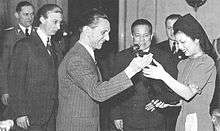Nejiko Suwa

Nejiko Suwa (諏訪根自子) (23 January 1920 – 6 March 2012)[1] was a Japanese violinist who first rose to prominence as a child prodigy during the inter-war period, and was most active prior to the 1960s. She is most noted today for having been presented with what was claimed to be a Stradivarius by the Nazi propaganda minister Joseph Goebbels, and the controversy surrounding the gift.[2]
Early life
Suwa was born as Nejiko Oga in Tokyo in 1920 and was recognized as a violin prodigy by the age of 10. Her first teacher was Nakajima Tazuruko, but she soon progressed quickly enough to study with his teacher, the Russian violinist Anna Bubnova-Ono. Suwa was introduced to Efrem Zimbalist while on his second Asian tour in 1930. Her performance of Mendelssohn's Violin Concerto in E minor impressed him enough that the meeting made headlines. He recommended that she study abroad and offered his assistance. While she did not take up this offer and continued to remain in Japan for six more years, she did decide to study under another Russian violinist, Alexander Mogilevsky.[3]
Europe and wartime

Having relocated to Brussels in 1936 to continue her studies with Mogilevsky, she moved once again to Paris, in 1938, to study with Boris Kamensky. She gave her European debut in the Salle de Chopin there on 15 May 1939. Although World War II broke out several months later, Suwa continued to stay in Paris to further her studies even after the Nazi regime occupied Paris. Nazi Germany and Imperial Japan, at this time, were united by the Tripartite Pact, and this military alliance allowed Suwa's career to flourish: she was allowed to give concerts to wounded German troops to strengthen the alliance.[2] Yusuke Fukada wrote a book about the early part of her life in Europe which was made into a TV film for TV Asahi in 1985 in which the Japanese violinist Mariko Komuro played the role of the young Suwa.
In recognition of her services to German troops and her "superb technique and a brilliant display of art"[2] on the instrument, Goebbels presented her with a violin on February 22, 1943. The gift was meant to be of a Stradivarius, and Goebbels himself noted in his diary that he was "offering the Japanese violinist a Stradivarius violin". In an interview with a Japanese newspaper Suwa also appeared to believe that the violin was a Stradivarius.[2]
Suwa was a featured soloist in a concert given by the Berlin Philharmonic under Hans Knappertsbusch in October 1943 and performed to great acclaim. She also continued to travel between German cities giving concerts, but was finally forced to flee Paris in August 1944 when the Allies closed in on the city. She joined Japanese Ambassador Ōshima's entourage in the Japanese Embassy in Berlin in April 1945 before moving with them to Bad Gastein when the war in Europe ended in May.[3] She was captured in the Austrian Alps with the entire Japanese diplomatic mission to Germany by the Seventh United States Army in May 1945. She and other Japanese nationals were placed on board the liner Santa Rosa, in Le Havre, France, bound for New York. They were briefly sent to Pennsylvania in August to be detained in the Bedford Springs Hotel in the heart of the Allegheny Mountains before being released in November and sent back to Japan.[2]
Postwar success
After the war, she was featured in a benefit concert at the Hollywood Bowl as the "first Japanese musical star to set foot on American soil since the signing of the peace treaty".[2] She also gave numerous concerts in Japan, including one to war criminals at Sugamo Prison in 1952.[4] After her years of public prominence were over, she released recordings of Bach's Sonatas and Partitas and Beethoven's Kreutzer and Spring sonatas.[3]
Suwa died on 6 March 2012 at the age of 92 in her home in Tokyo.[1]
Violin controversy
Controversy has stemmed from the possibility that she was indeed presented with a genuine Stradivarius.[3] It is alleged that it could have been one of many violins stolen or confiscated from Jews during the war. Stradivarius violins belonging to the Viennese art collector Oskar Bondy and the Jewish stepdaughter of Johann Strauss II are missing, and Goebbels and his ministry were known to be concerned with buying quality violins for German musicians. Military records, too, confirm that a 1765 Guadagnini was found on a German violinist who said it was a loan from Goebbels.[2]
However, the provenance of the instrument continues to remain uncertain. Suwa's nephew, the current owner of the violin, has declined to discuss the violin and authenticate it.[2]
References
- 1 2 "Obituary / Nejiko Suwa / Violinist". The Daily Yomiuri. Jiji Press. Retrieved 26 September 2012. archived at archive.is
- 1 2 3 4 5 6 7 8 Shapreau, Carla. "A Violin Once Owned by Goebbels Keeps Its Secrets". The New York Times. Retrieved 21 September 2012.
- 1 2 3 4 "Three Violin Maidens". Violinist.com. 2011. Retrieved 21 September 2012.
- ↑ Dower, John (1999). Embracing Defeat: Japan in the Wake of World War II. W. W. Norton. p. 514.
External links
![]() Media related to Nejiko Suwa at Wikimedia Commons
Media related to Nejiko Suwa at Wikimedia Commons
|